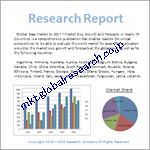目次
第1章.合成糸の世界市場
1.1.合成糸の世界市場規模・予測(2022年〜2032年)
1.2.地域別概要
1.3.セグメント別概要
1.3.1.糸タイプ別
1.3.2.繊維タイプ別
1.3.3.最終用途産業別
1.4.主要動向
1.5.不況の影響
1.6.アナリストの提言と結論
第2章.世界の合成糸市場の定義と調査前提
2.1.調査目的
2.2.市場の定義
2.3.調査の前提
2.3.1.包含と除外
2.3.2.限界
2.3.3.供給サイドの分析
2.3.3.1.入手可能性
2.3.3.2.インフラ
2.3.3.3.規制環境
2.3.3.4.市場競争
2.3.3.5.経済性(消費者の視点)
2.3.4.需要サイド分析
2.3.4.1.規制の枠組み
2.3.4.2.技術の進歩
2.3.4.3.環境への配慮
2.3.4.4.消費者の意識と受容
2.4.推定方法
2.5.調査対象年
2.6.通貨換算レート
第3章.合成糸の世界市場ダイナミクス
3.1.市場促進要因
3.1.1.軽量で耐久性のある素材の採用増加
3.1.2.繊維製品およびアパレル製品における合成糸の需要増加
3.1.3.糸製造プロセスにおける技術革新
3.2.市場の課題
3.2.1.特殊繊維の高い生産コスト
3.2.2.合成繊維廃棄物をめぐる環境問題
3.3.市場機会
3.3.1.家庭用家具と自動車産業における用途の拡大
3.3.2.持続可能なリサイクル合成糸への注目の高まり
第4章.合成糸の世界市場産業分析
4.1.ポーターの5フォースモデル
4.1.1.サプライヤーの交渉力
4.1.2.バイヤーの交渉力
4.1.3.新規参入者の脅威
4.1.4.代替品の脅威
4.1.5.競合他社との競争
4.1.6.ポーターの5フォース影響分析
4.2.PESTEL分析
4.2.1.政治的
4.2.2.経済的
4.2.3.社会的
4.2.4.技術的
4.2.5.環境
4.2.6.法律
4.3.主な投資機会
4.4.トップ勝ち組戦略
4.5.破壊的トレンド
4.6.業界専門家の視点
4.7.アナリストの提言と結論
第5章.合成糸の世界市場規模・糸タイプ別予測(2022年〜2032年)
5.1.セグメントダッシュボード
5.2.合成糸の世界市場ヤーンタイプ別売上動向分析(億米ドル、2022年・2032年)
5.2.1.フィラメント糸
5.2.2.紡績糸
第6章.合成糸の世界繊維タイプ別市場規模・予測(2022年〜2032年)
6.1.セグメントダッシュボード
6.2.合成糸の世界市場繊維タイプ別売上動向分析(10億米ドル、2022年・2032年)
6.2.1.ポリエステル
6.2.2.ナイロン
6.2.3.レーヨン
6.2.4.アクリル
第7章.合成糸の世界市場規模・予測:最終用途産業別(2022年〜2032年)
7.1.セグメントダッシュボード
7.2.合成糸の世界市場最終用途産業別売上動向分析(2022年・2032年、10億米ドル)
7.2.1.アパレル・家庭用家具
7.2.2.航空宇宙
7.2.3.自動車・運輸
7.2.4.工業
第8章.合成糸の世界地域別市場規模・予測(2022〜2032年)
8.1.北米の合成糸市場
8.1.1.米国
8.1.2.カナダ
8.2.ヨーロッパの合成糸市場
8.2.1.ドイツ
8.2.2.イギリス
8.2.3.フランス
8.2.4.スペイン
8.2.5.イタリア
8.2.6.ROE(その他のヨーロッパ)
8.3.アジア太平洋合成糸市場
8.3.1.中国
8.3.2.インド
8.3.3.日本
8.3.4.韓国
8.3.5.オーストラリア
8.3.6.RoAPAC(その他のアジア太平洋地域)
8.4.ラテンアメリカの合成糸市場
8.4.1.ブラジル
8.4.2.メキシコ
8.4.3.その他のラテンアメリカ
8.5.中東・アフリカ合繊糸市場
8.5.1.サウジアラビア
8.5.2.南アフリカ
8.5.3.RoMEA(その他の中東・アフリカ地域)
第9章.コンペティティブ・インテリジェンス
9.1.主要企業のSWOT分析
9.1.1.東レ
9.1.2.三菱化学株式会社
9.1.3.株式会社クラレ
9.2.トップ市場戦略
9.3.企業プロフィール
9.3.1.東レ
9.3.2.三菱化学株式会社
9.3.3.株式会社クラレ
9.3.4.デュポン
9.3.5.インドラマベンチャーズ
9.3.6.浙江恒基集団有限公司
第10章.研究プロセス
10.1.研究プロセス
10.1.1.データマイニング
10.1.2.分析
10.1.3.市場推定
10.1.4.バリデーション
10.1.5.出版
10.2.研究属性
表一覧
表1.合成糸の世界市場、レポートスコープ
表2.合成糸の世界市場の地域別推計および予測(10億米ドル、2022年〜2032年)
表3.合成糸の世界市場:糸タイプ別推計・予測(10億ドル、2022年〜2032年)
表4.合成糸の世界市場:繊維タイプ別予測・予測(2022-2032年、10億米ドル)
表5.合成糸の世界市場:最終用途産業別予測・予測(10億米ドル、2022年〜2032年)
表6.合成糸の地域別市場業績(2022年・2032年
表7.主要地域セグメントの成長動向
表8.主要企業の収益分析(2023年
図表一覧
図1.合成糸の世界市場、調査手法
図2.合成糸の世界市場、市場推定手法
図3.合成糸の世界市場規模推計と予測手法
図4.合成糸の世界市場、主要動向(2022年~2032年)
図5.合成糸の世界市場成長見通し(2022年〜2032年)
図6. 合成糸の採用動向(最終用途産業別
図7.2022年と2032年の繊維タイプ別シェア分析
図8.合成糸の地域別シェア分析
Synthetic yarns are available in an extensive array of colors, textures, and styles, making them indispensable in the textile industry, particularly for clothing and home furnishings. Two primary types of synthetic yarns dominate the market: filament yarns and spun yarns, each catering to specific applications based on their structural and performance characteristics.
The filament yarn type emerged as the leading segment in 2023, driven by its unique attributes such as smoothness, lightweight, and versatility. The manufacturing process of filament yarn involves extruding polymers through spinnerets, which are then twisted into smooth and durable threads. This type has become a preferred choice for high-quality fabrics due to its resistance to pilling and enhanced structural integrity.
Among the fiber types, polyester fibers led the market in 2023, capturing the largest volume share. As a petrochemical-based material, polyester offers an exceptional combination of strength, stretchability, moisture resistance, and wrinkle resistance. Its quick-drying property and low-maintenance features have ensured its dominance in industries demanding durability and performance.
The apparels and home furnishings segment continues to drive the end-use application market, contributing significantly to the global synthetic yarn market. With the rising demand for textiles due to increased consumer spending, changing lifestyle trends, and a focus on sustainable fabrics, this sector is set to maintain its growth trajectory.
The Asia Pacific region held the largest market share in 2023, fueled by urbanization, a burgeoning middle class, and the region's position as a global manufacturing hub. The increasing adoption of synthetic yarns across automotive, aerospace, and industrial applications underscores the region's robust market potential. Leading manufacturers are capitalizing on the region's low production costs and infrastructure to establish competitive advantages.
Major market players are actively pursuing innovation and regional expansion to leverage growing opportunities. Companies like Toray Industries, Inc., Teijin Limited, Kuraray Co., Ltd., and Reliance Industries Limited are spearheading advancements in synthetic yarn technologies, focusing on sustainability and performance optimization.
Major Market Players Included in This Report:
• Kuraray Co., Ltd. (Japan)
• Teijin Limited (Japan)
• Mitsubishi Chemical Corporation (Japan)
• DuPont (US)
• Toray Industries, Inc. (Japan)
• Zhejiang Hengyi Group Ltd. (China)
• Reliance Industries Limited (India)
• Indorama Ventures Public Company Limited (Thailand)
• Aksa Akrilik Kimya (Turkey)
• Lenzing Group (Austria)
• Eastman Chemical Company (US)
The detailed segments and sub-segments of the market are explained below:
By Yarn Type
• Filament Yarn
• Spun Yarn
By Fiber Type
• Polyester
• Nylon
• Rayon
• Acrylic
By End-Use Industries
• Apparels & Home Furnishings
• Aerospace
• Automotive & Transportation
• Industrial
By Region:
North America
• U.S.
• Canada
Europe
• Germany
• UK
• France
• Italy
• Spain
• ROE
Asia Pacific
• China
• India
• Japan
• South Korea
• Australia
• Rest of Asia Pacific
Latin America
• Brazil
• Mexico
Middle East & Africa
• Saudi Arabia
• South Africa
• Rest of MEA
Years considered for the study are as follows:
• Historical year – 2022
• Base year – 2023
• Forecast period – 2024 to 2032
Key Takeaways:
• Market Estimates & Forecast for 10 years from 2022 to 2032.
• Annualized revenues and regional level analysis for each market segment.
• Detailed analysis of geographical landscapes with country-level insights for major regions.
• Competitive landscape with information on major players in the market.
• Analysis of key business strategies and recommendations for future market approaches.
• Comprehensive analysis of competitive structure and demand-supply dynamics of the market.
❖ 免責事項 ❖
http://www.globalresearch.jp/disclaimer

